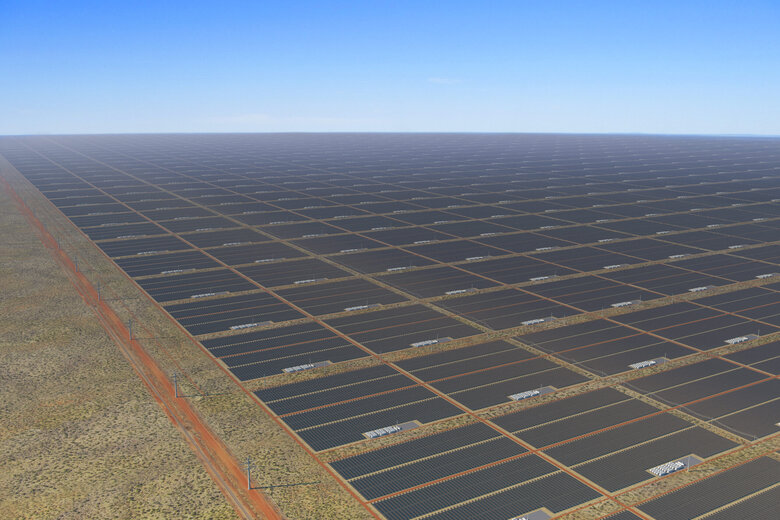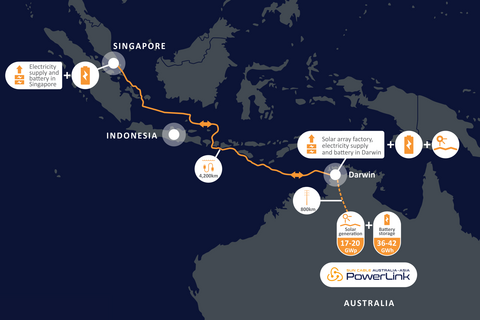
Australian company Sun Cable is working on an ambitious project to supply Southeast Asia with renewable energy, writes Dr Fiona Martin.

Affordable renewable energy technologies are key to Australia achieving net zero emissions by 2050 and adhering to our commitments under the Paris Agreement of reducing emissions to 42 per cent below 2005 levels by 2030.
Unlike neighbouring countries, Australia’s solar resource is extremely abundant. Australia has the potential to power the world 100 times over if we invest in the correct renewable energy technologies and projects.
Sun Cable is an Australian-founded renewable energy company with a mission to supply renewable electricity from resource-abundant regions such as Australia to regions with growing demand for electricity. Singapore, as well as Southeast Asia, are looking at a 6 per cent growth in demand per annum, resulting in a doubling of demand in 12 years.
To help meet this increasing demand, Sun Cable to developing the Australia-Asia PowerLink (AAPowerLink) project. AAPowerLink, which has been conferred Major Project status by the federal and Northern Territory governments, will create the largest solar farm and battery storage facility in the NT.
A 5000-kilometre transmission system will supply Darwin and Singapore with reliable and competitively priced renewable electricity. Financial close is expected to occur in 2024, with construction to commence after that.
The project will be the world’s largest solar generation site, the largest battery energy storage system and the longest subsea cable transmission system.
Economic and social benefits
The AAPowerLink project has significant economic and social benefits. It will create thousands of jobs, opportunities for local businesses and suppliers, as well as innovation and investment in Australia, Singapore and Indonesia.
The project will position Australia, Singapore and other markets in Asia as world leaders in cross-border renewable electricity trade. The developed infrastructure will facilitate large-scale industrial development through the electrification of new and existing industries, provide significant supply chain opportunities and support regional decarbonisation.
An estimated $8 billion of investment in Australia is expected from AAPowerLink, in addition to electricity exports from the Northern Territory, expected to be greater than $2 billion per annum. This is roughly the same as the dairy industry.

The project is one of the largest logistical undertakings in Australia’s remote Northern Territory to ever exist and there are significant infrastructure requirements which need to be met for the project to successfully play out.
Acceptance and approval of the project by the local community, Northern Territory Indigenous communities, government bodies, councils and Traditional Owner communities is critical.
Further, one of the greatest challenges, and also opportunities, of AAPowerLink is design optimisation. It is crucial the design of each component and the system delivers resilient supply at a competitive price.
Investing in large-scale solar export projects is key to Australia’s economic survival in a future that
will see renewable energy the preferred energy choice. Renewable energy currently makes up around 29 per cent of Australia’s total electricity generation, which is significantly less than neighbouring nation New Zealand’s total renewable energy supply of around 40 per cent, demonstrating Australia still has a long way to go to catch up to our global counterparts.
AAPowerLink will help position Australia as a leader on decarbonising the Indo-Pacific region.
Building strong relationships with our neighbouring countries is vital not only for working together with our neighbours to tackle climate change in the Southeast Asian region, but for maintaining strong trade partnerships.
Singapore is Australia’s largest trade and investment partner in the ASEAN and has a strong demand for reliable, competitively priced renewable electricity. If Singapore were to supply its entire 2040 electricity demand with locally produced solar, it would require 14 times the land that is currently available in the country.
The AAPowerLink project will help reduce global greenhouse gas emissions by eliminating 8.6 million tonnes of CO2 equivalent per annum in Darwin and Singapore.
This will set a much-needed example for other large scale solar project development around the world and be a catalyst for a new wave of solar technology innovation worldwide.
*Dr Fiona Martin is Regional Director Community Engagement and Social Performance with Hatch, which is working with Sun Cable on prefabrication and efficient logistics for the AAPowerlink.
Comment below to have your say on this story.
If you have a news story or tip-off, get in touch at editorial@governmentnews.com.au.
Sign up to the Government News newsletter
What a great project even if it as it appears at the concept stage( Note
not financially approved as yet ) No talk in this article about supplying Australias electricity grid though first which I would have thought would be top of the list given most connections would be within the 5000Km they are talking about here to get to Singapore. Maybe they think the uptake of solar panels here already will be enough to do the trick. I doubt it given the investment made and proposed in windfarms and other energy sources which will be greater than the $8 billion proposed here. Once again it appears Aus will be let down by commercial interests here. It amazes me that in what is an existential threat to our way of life that Governments together with private enterprise cannot pull together and all head in the same direction making efficient use of financial resources from both sectors to overcome the problem and give all Australians and I mean all Australians first access before heading overseas which I totally agree with on the second level of access. On a technical level I would be interested see how much power loss there would be over the distance both in Aus and the locations that will be hooked up in the Asia Pacific for a number of reasons